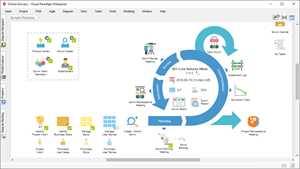Spikes are an invention of Extreme Programming (XP), are a special type of user story that is used to gain the knowledge necessary to reduce the risk of a technical approach, better understand a requirement, or increase the reliability of a story estimate. A spike has a maximum time-box size as the sprint it is contained in it. At the end of a sprint, the spike will be determined that is done or not-done just like any other ordinary user story. A Spike is a great way to mitigate risks early and allows the team ascertain feedback and develop an understanding on an upcoming PBI’s complexity.

Best Scrum Software Every Project Needs
A powerful scrum software that supports scrum project management. It features scrum tools like user story map, product backlog management, sprint backlog management, task management, daily scrum meeting, sprint planning tool, sprint review tool, sprint retrospective tool, burndown, impediment, stakeholder and team management.
Sometime the team unsure if they can complete the story due to some potential blockers and probably can’t even estimate the story. Thus, you may consider a spike as an investment for a Product Owner to figure out what needs to be built and how the team is going to build it. The Product Owner allocates a little bit of the team’s capacity now, ahead of when the story needs to be delivered, so that when the story comes into the sprint, the team knows what to do.
Here are the examples of when Spikes may be used:
Spikes primarily come in two forms: technical and functional. A distinction can be made between technical spikes and functional spikes:
The technical spike is used more often for evaluating the impact new technology has on the current implementation that the team needs experiment a new technology to gain more confident for a desired approach before committing new functionality to a timebox.
i.e. “how long it takes to update a customer display to current usage, determining communication requirements, bandwidth, and whether to push or pull the data”
A functional spike are used whenever there is significant uncertainty as to how a user might interact with the system. Functional spikes are often best evaluated through some level of prototyping, whether it be user interface mockups, wireframes, page flows, or whatever techniques is best suited to get feedback from the customer or stakeholders.,
i.e. “Prototype a histogram in the web portal and get some user feedback on presentation size, style, and charting”
Spikes should be estimated as in-Sprint tasks during Sprint Planning. The task’s duration should be spent researching and developing some ‘thing’ that can be delivered. That thing can be a working piece of software, workflow, documentation, etc. Ultimately the value from the spike is a direction or re-direction in the course of the feature. If the team estimated that a Spike takes four hours, then ONLY four hours should be spent researching or developing. Prototypes, Proof of Concepts (PoC), and Wireframes all fall into the classification of Spikes.
Just like any other ordinary user story, they need fulfil some certain criteria to obtain the status of done by making sure that the “Spike Story” estimable, demonstrable, and acceptable:
Estimable
Like other stories, spikes are put in the backlog, estimable and sized to fit in an iteration. Spike results are different from a story, as they generally produce information, rather than working code. A spike may result in a decision, a prototype, storyboard, proof of concept, or some other partial solution to help drive the final results.
In any case, the spike should develop just the information sufficient to resolve the uncertainty in being able to identify and size the stories hidden beneath the spike.
Demonstrable
The output of a spike is demonstrable to the team. This brings visibility to the research and architectural efforts and also helps build collective ownership and shared responsibility for the key decisions that are being taken.
Acceptable
And like any other story, spikes are accepted by the product owner when the acceptance criteria for the spike have been fulfilled.
| About Visual Paradigm |
 Visual Paradigm help organizations stay competitive and responsive to change faster and better in today’s fast changing environment. Our award-winning products are trusted by over 320,000 users in companies ranging from small business, consultants, to blue chip organizations, universities and government units across the globe. It enables organizations to improve business and IT agility and foster innovation through popular open standards and process frameworks.Visual Paradigm, a killer Agile feature in 2018, introduced Scrum Process Canvas for automating the way a Scrum team to create, manage and deploy software application that empowers the team to continuously improve their performance at unprecedented speed and scale. Visual Paradigm help organizations stay competitive and responsive to change faster and better in today’s fast changing environment. Our award-winning products are trusted by over 320,000 users in companies ranging from small business, consultants, to blue chip organizations, universities and government units across the globe. It enables organizations to improve business and IT agility and foster innovation through popular open standards and process frameworks.Visual Paradigm, a killer Agile feature in 2018, introduced Scrum Process Canvas for automating the way a Scrum team to create, manage and deploy software application that empowers the team to continuously improve their performance at unprecedented speed and scale.
Manage the Entire Scrum Process in One Page
|